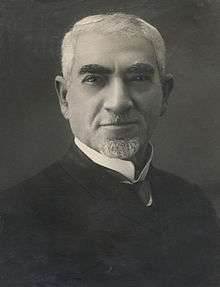Nar-Dos
Michael Hovhannisyan (Armenian: Միքայել Հովհաննիսյան, March 1, 1867 – July 13, 1933), known by the pen name Nar-Dos (Armenian: Նար-Դոս), was an Armenian writer.
Nar-Dos Նար-Դոս | |
|---|---|
 | |
| Born | March 1, 1867 Tiflis, Tiflis Governorate, Russian Empire |
| Died | July 13, 1933 (aged 66) Tiflis, Transcaucasian SFSR, Soviet Union |
| Occupation | Writer |
| Nationality | Armenian |
Biography
Nar-Dos was born to a wool seller's family in Tbilisi, Georgia in 1867. He started his education in a parochial school of Saint Karapet Church, and he continued it in Nicolaev Municipal School. He later entered Khon Seminary, Kutaisi, which he did not finish because of scarcity of living, and returned to Tbilisi. He was engaged in the profession of a locksmith at Michaelian craft school where he met Armenian poet Alexander Tsaturyan.
A year later Nar-Dos left Michaelyan craft school and started practicing journalism. In 1890–1906 he was the responsible secretary of the periodical Nor dar ("A New Century"; Armenian: "Նոր դար"). He worked as a secretary and proofreader at the journal Aghbyur-Taraz ("Source of Fashion"; Armenian: "Աղբյուր-Տարազ") in 1903, and in the newspaper Surhandak ("Courier"; Armenian: "Սուրհանդակ") from 1913–1918.
Nar-Dos began writing in the 1880s starting with poems, some of which were published in Araks (Armenian: "Արաքս") in Saint-Petersburg, Russia, and "Sokhak Hayastani" ("The Nightingale of Armenia" Armenian: "Սոխակ Հայաստանի") poetry collections. He also wrote stories, satirical articles and plays. Under the influence of Gabriel Sundukian, Nar-Dos created the plays "Mayin's Complaint" ("Մայինի գանգատը"), “Honey and flies” («Մեղր և ճանճեր») (1886),[1] and “Brother” («Եղբայր»)[2] (1887).
Under the pen name of Mikho-Ohan he published “Tchshmarit barekamy” («Ճշմարիտ բարեկամը»),[3] “Nune” («Նունե»)(1886),[4] («Բարերար և որդեգիր») (1888),[5] “Knkush larer” («Քնքուշ լարեր») (1887), [6] and “Zazunyan” («Զազունյան») (1890)[7] in the newspaper Nor dar.
In the stories and novels of his first period he mainly describes the urban life focusing on certain social groups (“Our District” («Մեր թաղը»),[8] "Hopop" (1890), "Hogun vra hasav" ("Հոգուն վրա հասավ") (1889), "Anna Saroyan" ("Աննա Սարոյան") (1888)). One of the famous stories of this period is “Me and Him” («Ես և նա»),[9] written in 1889.
After 1890 a new period began in Nar-Dos' creative life, in which deep psychological analysis was typical. Famous works of this period are “The Killed Dove” («Սպանված աղավնին») (1898),[10] in which the author depicts the tragedy of an Armenian woman, “Struggle” («Պայքար») (1911), [11] and “The Death” («Մահը») (reedited in 1912).[12]
Nar-Dos developed the psychological trend of Armenian critical realism displaying refined Armenian language.
Nar-Dos died in 1933 in Tbilisi.[13] He is buried in Khojivank Armenian cemetery.[14]
References
- “Honey and flies” («Մեղր և ճանճեր»)
- “Brother” («Եղբայր»)
- “Tchshmarit barekamy” («Ճշմարիտ բարեկամը»)
- “Nune” («Նունե»)
- “Barerar ev vordegir” («Բարերար և որդեգիր»)
- “Knkush larer” («Քնքուշ լարեր»)
- “Zazunyan” («Զազունյան»)
- “Our District” («Մեր թաղը»)
- “Me and Him” («Ես և նա»)
- “The Killed Dove” («Սպանված աղավնին»)
- “Struggle” («Պայքար»)
- “The Death” («Մահը»)
- Armenian Encyclopedia, v. 8, pp 2–203
- Nar Dos' grave on hush.am
- A. J. Hacikyan; Gabriel Basmajian; Edward S. Franchuk; Nourhan Ouzounian, eds. (2005). The Heritage of Armenian Literature: From the eighteenth century to modern times. 3. Detroit: Wayne State University Press. pp. 602–608. ISBN 9780814330234.
External links
- «Սպանված աղավնի» (in Armenian)
- «Անհետ կորածը» (in Armenian)
- «Ազատամտության դրոշակակիրը» (in Armenian)
- «Եղբայր» (in Armenian)
- «Հենակներով մարդը» (in Armenian)
- «Քնքուշ լարեր» (in Armenian)
- «Մահը» (in Armenian)
- «Մեղր և ճանճեր» (in Armenian)
- «Նեղ օրերից մեկը» (in Armenian)
- «Նոր մարդը» (in Armenian)
- «Պայքար» (in Armenian)
- «Մեր թաղը, զանազան պատմվածքներ, վիպակներ, հեքիաթներ» (in Armenian)
- «Զազունյան» (in Armenian)
- «Ես և նա» (in Armenian)
- Nar-Dos biography in Russian